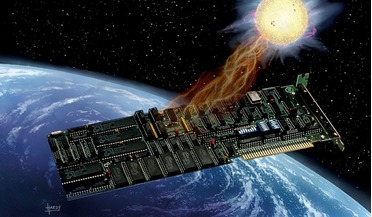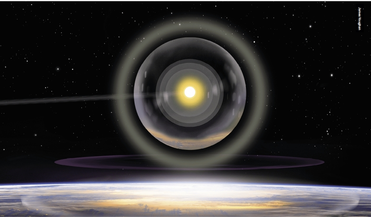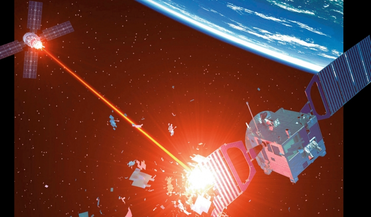ROOM: The Space Journal is one of the prominent magazines on space exploration, technology and industry. At ROOM, we share a common dream – advancement of peaceful space exploration for the benefit of humankind, all while bringing you detailed articles on an array of contemporary topics. Our authors include academics and industry leaders from all over the world, which lets us bring you the most up-to-date and comprehensive information about space probe sputnik definition.
 March 2016
Why We Need Space Artists
March 2016
Why We Need Space Artists
... will always be a need for artists (quite apart from the aesthetic aspects; space art can be at least as beautiful as terrestrial art) because from space probes we only see the whole object – planet, moon, comet - or close-ups of ... plus a 3D model of New Horizons by Dan Durda added in 2015. Note the atmospheric haze, the similarity to Sputnik Planum, and the chasms on Charon! (Gouache + digital) Gemini 6 and 7 docking in December 1965. There was...
 March 2021
Space weather and risk mitigation
March 2021
Space weather and risk mitigation
...be observed at the time a recovery plan must be implemented. This increases the assessment complexity and definition of the hazard scenario. The SMILE aims to form an accurate picture of solar-terrestrial magnetospheric physics... including the global navigation satellite system (GNSS), communication satellites, Earth observation systems, space probes and even CubeSats. Therefore, the operation of the whole spectrum is of high importance. Disaster ...
 March 2016
Space Mining – the Reality of Tomorrow?
March 2016
Space Mining – the Reality of Tomorrow?
... as smart as humans and possess sophisticated ‘thinking’ skills, space probes that can be used to bring us new resources and clean energy from space and also protect our critical infrastructure from cosmic hazards. Scale...Despite these provisions there are at least four private entities seeking to engage in space mining activities. One of the key question is exactly what the definition of a celestial body is and to what extent a small asteroid of ...
 January 2021
Time to change our relationship with space?
January 2021
Time to change our relationship with space?
... unsurprising - while most of the media champion human spaceflight as the primary definition of space, over 90 percent of space revenue actually comes from satellite systems and services. Furthermore, the use of ...arrived at a crossroads in our understanding of Space - one where we now recognise Space as truly about satellites and space probes; the benefits they offer our space-enabled economies, the opportunities they offer for sustainable...
 April 2021
Space wars - how they start and how to end them
April 2021
Space wars - how they start and how to end them
The world has come a long way since the first artificial satellite, Sputnik, was launched in 1957. The entire planet now depends on space for economic, military, diplomatic and civilian uses and it is hard to...miscalculation and/or misperceptions. This all depends on senior leaders’ conceptions and/or fears of the threats posed by space systems to their countries’ national security or even their own political futures and, of course, the perception...
 June 2022
Military space – how worried should we be?
June 2022
Military space – how worried should we be?
...Sputnik used a rocket initially designed as an intercontinental ballistic missile and Explorer the A-4 derived Redstone. Ironically, it was a General, also President, Eisenhower who insisted on keeping a blue sea between ‘military’ space and ‘civilian’ space, with an all-civilian space...satellite. By the 1980s, though, the concealment of military space within ‘civilian’ space by all the space powers became less and less feasible or credible A more ...
 February 2022
Revolution and responsibility: the challenges of space
February 2022
Revolution and responsibility: the challenges of space
... themselves: by crossing the atmospheric and (partially) the gravitational barrier, humans have not definitively undone the links that unite them with the Earth; instead, they have reconnected them....and the exploration of the solar system (the sterilisation of probes and, more broadly, planetary protection). Tomorrow, it will be necessary to organise and govern the exploitation of space resources, in particular mining. This is a subject that is...
 February 2020
Preserving our space heritage
February 2020
Preserving our space heritage
... is because they either re-entered the Earth’s atmosphere long ago and burned up - the fate that befell Sputnik in 1958, for instance - or because they’re still in orbit around the Earth, or sitting on other ...a satellite is still likely to need attitude control and thermal management to maintain its physical integrity in the space environment. There are also hazards ‘up there’ which exhibits in terrestrial museums do not have to endure. Radiation...
 July 2019
Who owns outer space?
July 2019
Who owns outer space?
... an “ideological charter for the Space Age”, having come into force in 1967 amidst the tense atmosphere of the Cold War. According to lawyer and scholar, Carol R Buxton, the launch of Sputnik in 1957 sent “waves of ... problem and... therefore, only subject to a political solution. Without supportive political action to develop the law of space, space lawyers are reduced to the 20th century version of arguing the number of angels that can sit on the...